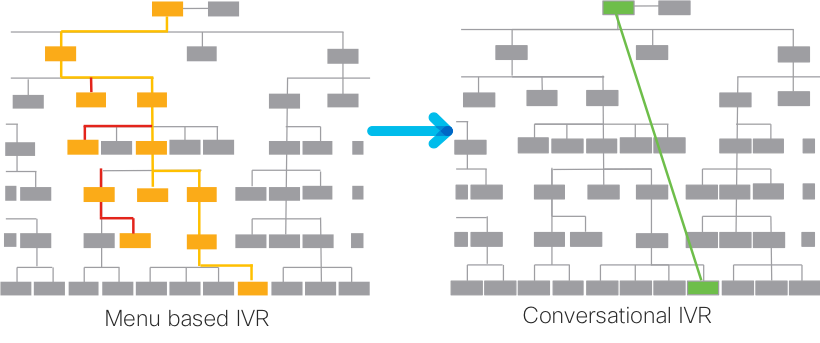A Cognitive IVR has the ability to engage in a natural language based conversation with a customer and take automated action based on the callers needs, thus resulting in a fully automated customer voice interaction. Here we'll discuss the basics of a Cognitive IVR and why Conversational AI should be part of your Cognitive Contact Center or Call Center Automation strategy.
Intelligent Front Door
Most on Premise IVRs use whats referred to as a *Directed Dialogue* method of capturing a customer's information to either handle the caller's need, or route them to the appropriate agent skill group. No doubt, you're used to hearing "Press or say 1 if you're an existing customer. Press or say 2 if you're calling to place a new order"... These are examples of course, and the actual prompts will vary based on the call center.
Directed Dialogue flows have been around since the advent of the IVR, and typically don't create a great first impression for your customer support.
As a real world example, I recently called Dyson's customer support line and spent a full 2 minutes just navigating their IVR and listening to recorded messages that didn't pertain to me, before I got to an agent. This does not make for a quality customer experience. What's worse is that my problem wasn't resolved the first time and I had to call back a week later and go through the entire process again.
Contrast this experience with a Cognitive IVR that politely greets the caller and then asks “How may I help you today" and then takes the appropriate self-service action or routes them to the best agent or queue. Cognitive IVRs can even provide personalized service and routing based on customer specific information.
With Conversational IVR, gone are the days of wading through layers of IVR prompt menus. Now you can provide the level and quality of automated customer service you've always dreamt of.
Implementing an Intelligent Front Door with Xaqt's Cognitive Voice Automation Suite is easy and can improve your customer experience on day one.
Knowledge Base and Troubleshooting
Before evaluating whether or not a Cognitive IVR or Conversational AI can benefit your organization, its critical to have a grasp on the nature of your existing call types and why customers are calling you today.
One common call driver is for customers calling with product questions or in need of basic troubleshooting information. Many companies create online knowledge bases and support portals with Frequently Asked Questions (FAQs) or articles. While these may be effective in deflecting a small percentage of overall customer support issues, often times the customer is still going to pick up the phone and call your customer support number.
Traditionally, these types of calls require an agent to handle. On premise IVRs simply don't have the ability to accept open ended questions from a customer and then identify the best way to respond to their needs.
To handle these types of calls well requires:
- effective Natural Language Processing (speech-to-text)
- to understand the customer's question or issue they're having (natural language understanding)
- the ability to search and identify the appropriate knowledge base article and response
- read the article to the caller in a manner that feels like a natural conversation (text-to-speech)
I was recently at O’Hare airport and had difficulty getting on the WiFi. I called Boingo customer support, where I waited in queue for several minutes. The agent was able to address my issue by asking a one simple question and then pointing me in the right direction. That call probably cost Boingo $5 to be handled by a live agent. Whereas with Xaqt's Cognitive IVR, it would have cost them less than $.50, and I would have been able to get online quicker.
Thus the power of a Conversational AI IVR. Xaqt's Cognitive Voice Automation Suite uses best in class Speech-to-Text technology along with cutting edge Natural Language Understanding tools to analyze what the caller is looking for and how to best help them. It also includes a Question and Answer (Q&A) engine that is optimized for knowledge search, or it can connect directly to popular support portals and knowledge bases, such as: Zendesk or Happy Fox.
If you have an existing knowledge base or FAQs, this can be an excellent starting place and can accelerate your deployment time. Xaqt's team of Cognitive Engagement analysts will work with you to structure your questions and answers in a way that best supports voice automation and Conversational AI.
Cognitive Automation
With many calls, some type of action needs to happen in order to fulfill the customer's request. This could be a dynamic order look-up from an e-commerce platform like Shopify or a CRM system such as Salesforce.com or ServiceNow. Or perhaps the customer needs to change their appointment time or reservation.
In this scenario, once your Conversational AI engine has discerned why the customer is calling, it needs to be able to take automated action. This requires technical integration with the underlying business systems. Usually this is done via APIs, but with most existing IVRs that can be an expensive integration. Whereas, Xaqt's Cognitive Voice Automation suite has turnkey integrations for many common systems and can be integrated into any existing customer platform you use today.
The business logic and rules can reside either in the underlying business systems, or they can reside in the Cognitive Automation platform itself.
Performance and Customer Experience Analytics
A well designed Cognitive IVR will produce valuable insights into your contact center and customers. Each interaction with a customer produces a transcript of the call. These transcripts serve as the foundation for true Customer Experience Analytics.
Conversational Cloud IVR
Some on premise IVR vendors are adding conversational AI abilities to their legacy platforms, however there are many benefits to going with a Cloud based Conversational IVR, such as Xaqt's Cognitive Voice Automation portal.
- Since you only pay for what you use, you're not paying for idle trunks or capacity
- Take advantage of ongoing innovations in the cloud. Natural Language Processing and Understanding are getting better every day.
- Easy to set-up, test and get going. You can start small with a few call types and scale from there.
- Ongoing changes and maintenance is a breeze.
- Can be provisioned on-demand during call volume spikes or periods of high call volume
Virtualize Multiple Call Centers
Another benefit to a Cloud based Conversational IVR is the ability to create a unified call routing and IVR platform across multiple call centers.
If you have more than one call center, maintaining multiple on premise IVRs can be painful and expensive. With a cloud based IVR, you can virtualize your Intelligent Front Door across all of your call centers




